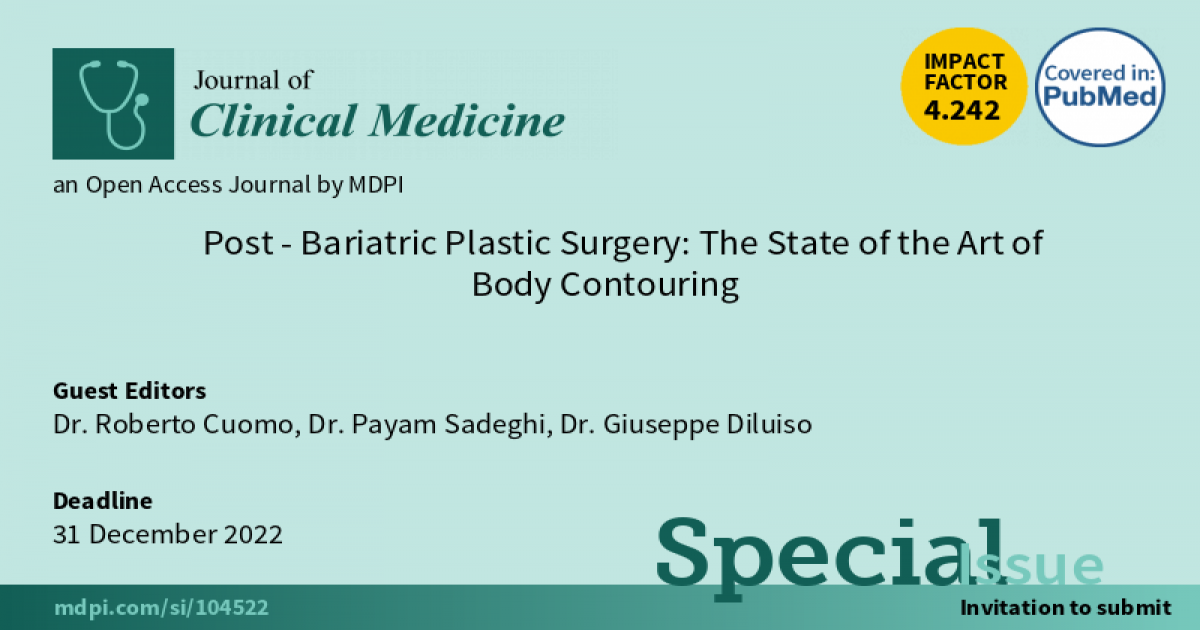The 10th Anniversary of JCM-Post-bariatric Plastic Surgery: The State of the Art of Body Contouring for 'Plastic, Reconstructive and Aesthetic Surgery/Aesthetic Medicine' Section
A special issue of Journal of Clinical Medicine (ISSN 2077-0383). This special issue belongs to the section "Plastic, Reconstructive and Aesthetic Surgery/Aesthetic Medicine".
Deadline for manuscript submissions: closed (31 December 2022) | Viewed by 10467

Special Issue Editors
Interests: plastic surgery; regenerative surgery; wound care; breast reconstruction; nipple–areola reconstruction; body-contouring surgery
Special Issues, Collections and Topics in MDPI journals
2. Plastic Surgery Department, Cleveland Clinic, Cleveland, OH, USA
Interests: reconstructive plastic surgery; microsurgery; free flap; body contouring; abdominoplasty; panniculectomy; aesthetics
Special Issue Information
Dear Colleagues,
According to the WHO the percentage of overweight patients in the world is 39% (39% of men and 40% of women), while the percentage of obese patients (BMI>30) is 13% (11% of men and 15% of women).
In 2001, the WHO introduced the term "globesity" by combining the words globe and obesity with the purpose of defining and highlighting the ever-growing obesity epidemic. This trend led to the development and improvement of disciplines such as food science and bariatric surgery.
The improvement of surgical techniques for weight loss have led to the definition of "post-bariatric" population, that includes patients with large amount of skin needing of body reshape.
As a direct consequence post-bariatric plastic surgery is receiving a substantial input for standardization of procedures.
A lot of techniques have been described to obtain good results and many researchers are focused also on medical procedures to increase outcomes. Clarity is needed on this topic based on scientific evidences.
The role of plastic surgeon is crucial in order to "redefine" and "restore” (in terms of form and function) the ideal anthropomorphic proportions and geometries for the patient. A restoration of individual integrity and a redefinition of body harmony.
This Special Issue of Journal of clinical medicine entitled “Post bariatric plastic surgery: the state of the art of body contouring” welcomes the submission of basic or clinical original articles, as well as systematic reviews, meta-analyses, and overviews, that discuss limits and points of strenght of techniques for body contouring as well as innovations and evolutions in this field.
Dr. Roberto Cuomo
Dr. Payam Sadeghi
Guest Editors
Manuscript Submission Information
Manuscripts should be submitted online at www.mdpi.com by registering and logging in to this website. Once you are registered, click here to go to the submission form. Manuscripts can be submitted until the deadline. All submissions that pass pre-check are peer-reviewed. Accepted papers will be published continuously in the journal (as soon as accepted) and will be listed together on the special issue website. Research articles, review articles as well as short communications are invited. For planned papers, a title and short abstract (about 100 words) can be sent to the Editorial Office for announcement on this website.
Submitted manuscripts should not have been published previously, nor be under consideration for publication elsewhere (except conference proceedings papers). All manuscripts are thoroughly refereed through a single-blind peer-review process. A guide for authors and other relevant information for submission of manuscripts is available on the Instructions for Authors page. Journal of Clinical Medicine is an international peer-reviewed open access semimonthly journal published by MDPI.
Please visit the Instructions for Authors page before submitting a manuscript. The Article Processing Charge (APC) for publication in this open access journal is 2600 CHF (Swiss Francs). Submitted papers should be well formatted and use good English. Authors may use MDPI's English editing service prior to publication or during author revisions.
Keywords
- Body Contouring
- Abdominoplasty
- Panniculectomy
- Liposuction
- Mastopexy
- Lasers
- Reduction Mammoplasty







